Mud
Griping about it seems peevish if not gallingly insensitive while a good portion of the nation’s midsection is suffering from the effects of widespread flooding, but I feel compelled to offer a few words on the topic of mud.
The thing is, we don’t see it much. In these parts, mud is a relative rarity. Its lack is one aspect of life on high ground: we live on terrain that tends to be anything other than flat. Water is inclined to be elsewhere, namely someplace downhill.
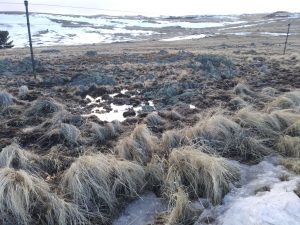
Meltwater pooled in rock.
The elevation of our place is such that we are the source of silt and sediment rather than the recipient of it. The dearth of flat terrain offers scarce habitat for pooling water; ushered downslope by gravity, water leaves the area at a pace that’s not usually conducive to canoodling with dirt long enough to create muddy progeny.
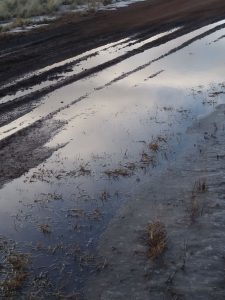
A puddle less conveniently located; at its height it covered the road.
Come to think of it, we don’t have an overabundance of dirt in the first place. Soil is slow to form in this semi-arid climate, with lush growth and speedy decomposition deterred by a lack of rain and humidity. Much of what passes for soil here would be referred to as fine gravel most other places: it is gritty, grainy, and non-absorbent. Water percolates swiftly through, filtering into hidden fissures. The sere air sucks moisture fast, too, with precipitation quickly met by evaporation.
Although we didn’t receive the dumps of snow that fell on some regions of Colorado this winter, a lot of what did fall, from October on, stuck around. When temperatures finally began to ratchet up and stick around long enough to melt accumulated sheets and drifts, still-frozen ground helped hold the resulting meltwater on the surface.
And so: mud happened.
Portions of the driveway walked through the garage and onto the doormats with each return trip from the barn or woodshed. No matter how often I vacuumed the rugs, wee chunks of grit and glittery mica-laced fines migrated upstairs, crunchy on wood and tile.
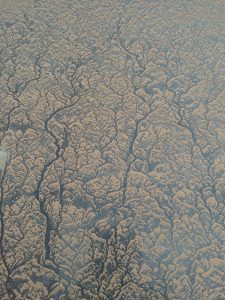
Mud art on the back window of the truck’s camper shell.
The local roads caked into wheel wells and splattered up car doors. Dust from drier sections of road between home and pavement wetted in the grimy spray thrown up on wet stretches, forming swirly red patterns on the back of the truck, an unplanned experiment in fluid dynamics.
The driveway and the road puddled and rutted. Under other circumstances, I might have been able to convince myself that the goo weighting down my boots every time I went outside was a good workout, but conditions were slick and a bout with the flu left me tired and very, very cranky. Going for a walk was singularly unpleasant there for a while; the roads were gloppy and slippery, the grasslands treacherous with crusted layers of old rotten snow or sheets of lumpy ice.
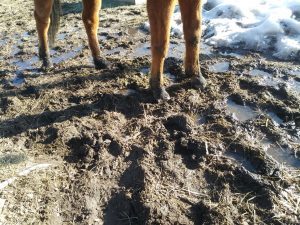
Braving the ick, after the mud began to dry.
The horses squished around, also cranky, mincing through the unstable and foot-sucking black grease around their feed tanks with ears pinned flat. That area is one of the few flat spots on our place, which makes it both a convenient feeding station and a logical location for the driveway. The downside is that it’s just below the crest of the ridge, which invites the drifting of snow. In the eons before we arrived, the extra moisture from winter drifting encouraged grass, yielding a nice layer of topsoil. That rich black earth, churned by the horses’ hooves, creates a boggy mess when it’s wet. Poor Moondo, who is fussy by nature and also now elderly and less steady on his feet, was particularly distressed by the glop. He would try to edge along on the drier grass next to the fence, or totter along the icy edge of the decomposing snowdrift. I watched him wallow through the drift one day, testing a route through crusty snow. I guess high-stepping his sore arthritic knee through the snow was worse than the mud, because he went back to picking his way through the goop.
Within a couple of weeks, though, the ground opened up enough to draw the water down from below, while the wind did its work from above.
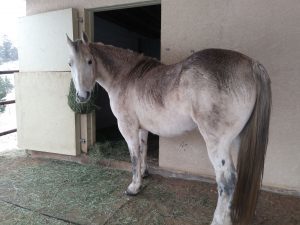
“Mud? What mud?”
Ruts hardened on the road, and now jostle our vehicles like train cars switching tracks. Footprints sploodged into mud have hardened like ancient petrified trackways, documenting our perambulations. I finally washed my car a few days ago, leaving a red outline in the wash stall down in town, a few pounds of sediment fast-tracked from the high country to an elevation three thousand feet lower.
###



